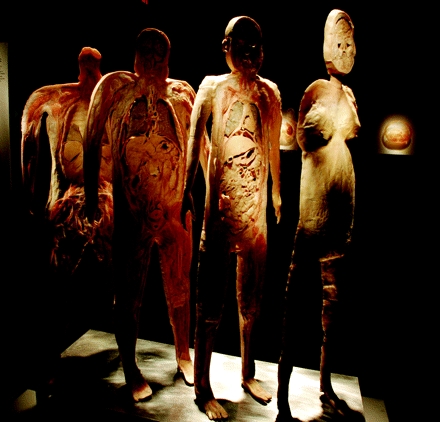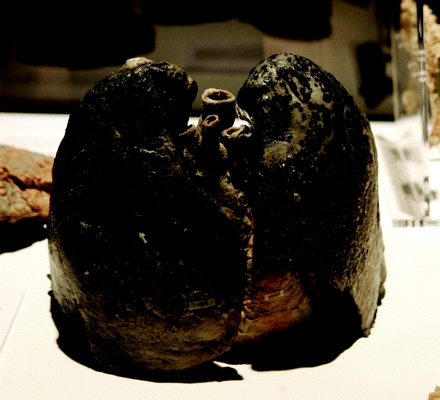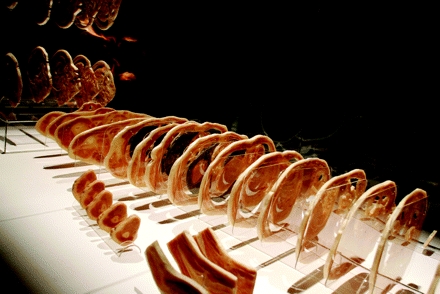ANATOMICAL EXHIBITIONS have been proliferating in North America since the Los Angeles debut of Body Worlds in 2004. The human bodies in the exhibitions undergo a process of polymer impregnation or plasti-nation that replaces body fluids with various polymers that impede organic decay. Exhibitions continue to be very popular, expanding their presence from museums to science centers and casinos. “Bodies . . . The Exhibition” opened in spring 2007 at the Tropicana Resort and Casino in Las Vegas, Nev, alongside the Folies Bergère and “Xtreme Magic Starring Dirk Arthur.”1
The goal of this exhibition is ambitious yet simple: to educate the public and to change the way people look at the human body. Roy Glover, PhD, chief medical adviser for Premier Exhibitions (the promoter firm), says that the exhibition has a remarkable effect on visitors, who are leaving behind their packs of cigarettes and unhealthy eating habits.2 The exhibitions take the visitor through an array of diseased and healthy organs, whole bodies, and body parts. Classic specimens such as the smoker’s lungs or death by obesity may be particularly compelling. A companion Web site features educational pages with classroom extension activities, a teacher’s guide, and facts for kids of all ages, but it remains unclear what knowledge or skills visitors acquire. For all its transformative power, the exhibition does not provide any evidence of lasting changes in the habits of its visitors, so its potential contribution to public health remains untested and unproven. What is evident from the general outpouring of enthusiasm and criticism toward these exhibitions is that they provide a profound—and to some, disturbing—cadaver experience.
The specimens in “Bodies . . . The Exhibition” were obtained from the plastination laboratories at Dalian Medical University, Dalian, China.3 Glover specifies that the bodies are “unclaimed,” like many bodies used for educational purposes in the United States.4 Many medical schools in the United States, however, have established “willed body donor programs” through which one can bequeath remains to a particular institution or program. Current body procurement trends favor donation, but unclaimed bodies still make up about 20% of bodies used in North American medical schools.5 Unclaimed bodies also tend to be those of institutionalized or socially and economically marginalized individuals (homeless persons or undocumented migrants).6 Moreover, potential claimants may be unable to make a claim because they cannot pay funerary expenses, lack legal proof of their relationship to the deceased, or cannot provide it all in a timely manner; so the use of unclaimed bodies remains problematic in North America as elsewhere.
The provenance of the exhibited bodies also raises questions. In fact, “normal” body procurement processes in China have recently and increasingly come under attack for exploiting prisoners, ethnic minorities, and religious minorities. In 2006, the Chinese government issued a moratorium banning “the trade and commercial use of corpses,” a step that was welcomed by the World Health Organization as a way to “help target brokers who had exploited loopholes in China’s legal framework to arrange the sale of organs from executed prisoners.”7 Glover explains that exhibition specimens are essentially leased from the medical school in China that obtained them through these “normal processes” and that they “would be used at a medical school for education and research in just the same way.”2 China’s new regulations grant exceptions for specimens used in medical research but ban all other uses.7
But does the use of cadavers in anatomy exhibitions constitute research? In the United States, the Code of Federal Regulations clearly defines research as the “systematic investigation, including research development, testing and evaluation, designed to develop or contribute to generalizable knowledge.”8 This definition falls outside the scope of the educational mission articulated by Glover and Premier Exhibitions. On the other hand, Premier Exhibitions may be operating under a lease or exchange agreement that precedes the moratorium, in which case, the new regulations may not be legally applicable to its exhibitions.
The relevant question, however, is an ethical one rather than a strictly legal one. Historically, willed body programs were established to create a reliable source of anatomical specimens. The nature of reliability here is twofold, serving the time-sensitive needs of medical school curricula and respecting the individual autonomy and self-determination of body donors. Glover explains that the decision to partner with a medical school in China was driven by the fact that they have the “best dissectors in the world,”2 but other anatomists disagree with these claims of exceptional expertise, citing inaccurate simplifications in the descriptions of body systems. Some critics fear that potential donors might be put off by the commercial character of the exhibitions and that they may be counterproductive for body donation and the advancement of anatomical science in the academic setting.
Frustrated by the “profiteering” of plastination exhibitions to popularize and sensationalize anatomical sciences, Jon Jackson, at the University of North Dakota School of Medicine, Grand Forks, has a hard time coming up with a compelling argument for body donation in the face of commercial interests brought in by exhibition promoters. Jackson explains that willed body programs “have to beg people for bodies. [They] have to remind people of what a big gift it is and for what altruistic purposes this gift is being made” (oral communication, January 22, 2007). In the meantime, Elaine Catz, of the Carnegie Science Center in Pittsburgh, Penn, where “Bodies . . . The Exhibition” opened in October 2007, resigned in protest after 11 years.9 Catz said, “There are a lot of so-called ‘assurances’ about this exhibit, but I’m not sure the Carnegie Institute investigated it far enough. . . . Asking questions is the only way scientists learn anything, but you have to verify the sources. . . . The science center is willing to accept the answer they want to hear, without verification, because they want this show to bring in the crowds.”9
Ultimately it is the responsibility of producers and consumers of education and entertainment to negotiate the ethical uncertainties of cadaver displays. The responsibility is individual, institutional, and disciplinary. The unanswered question is the same: if anatomy exhibitions are educational, what are they teaching us and at what price?
Figure 1.

Slices of an obese woman whose organs were damaged by overeating.
Source. From “Bodies...The Exhibition.” Image by Nancy Kaszerman. Courtesy of Corbis.
Figure 2.

A human body holding a football, depicting how the muscles work.
Source. From “Bodies...The Exhibition.” Image by Nancy Kaszerman. Courtesy of Corbis.
Figure 3.

Veins surrounding a skeletal head.
Source. From “Bodies...The Exhibition.” Image by Nancy Kaszerman. Courtesy of Corbis.
Figure 4.

A smokers black lungs and heart.
Source. From “Bodies...The Exhibition.” Image by Nancy Kaszerman. Courtesy of Corbis.
Figure 5.

A body in slices.
Source. From “Bodies...The Exhibition.” Image by Nancy Kaszerman. Courtesy of Corbis.
Acknowledgments
Images were selected for the article by Aleisha Kropf. Thanks to Michael Sarpol for his critique of a previous draft.
REFERENCES
- 1.Las Vegas Tropicana. Bodies . . . The Exhibition. Available at: http://www.tropicanalv.com/ent_bodies.asp. Accessed July 12, 2007.
- 2.Exhibits promote human remains as . . . art. Talk of the Nation. National Public Radio. March 24, 2006. Available at: http://www.npr.org/templates/story/story.php?storyId=5299802. Accessed July 12, 2007.
- 3.Jacobs A. Cadaver exhibition raises questions beyond taste [editor’s note appears in New York Times, January 7, 2006]. New York Times. November 18, 2005:B3. Available at: http://tinyurl.com/20v427. Accessed August 10, 2007.
- 4.Ulaby N. Origins of exhibited cadavers questioned. All Things Considered. National Public Radio. August 11, 2006. Available at: http://www.npr.org/templates/story/story.php?storyId=5637687. Accessed July 12, 2007.
- 5.Dasgupta N. Unclaimed bodies at the anatomy table. JAMA. 2004;291:122. [DOI] [PubMed] [Google Scholar]
- 6.Jones DG. Use of bequeathed and unclaimed bodies in the dissecting room. Clin Anat. 1994;7(2):102–107. [Google Scholar]
- 7.Reuters. Commercial trade in corpses banned. July 17, 2006. Available at http://go.reuters.com/newsArticle.jhtml?type=oddlyEnoughNews&storyID=12862993. Accessed July 17, 2006.
- 8.Code of Federal Regulations, title 45, part 46 (2005). Available at: http://www.hhs.gov/ohrp/humansubjects/guidance/45cfr46.htm. Accessed July 12, 2007.
- 9.Kalson S. China “Bodies” exhibit raises hackles here: Science Center employee quits to protest display of corpses. Pittsburgh Post-Gazette. June 21, 2007. Available at: http://www.post-gazette.com/pg/07172/795948-115.stm. Accessed July 12, 2007.


